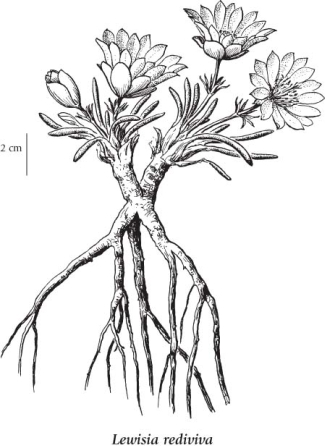Lewisia rediviva Pursh
bitterroot (bitter root)
Montiaceae (Purslane family)
(Previously in Portulacaceae)
Introduction to Vascular Plants
bitterroot (bitter root)
Montiaceae (Purslane family)
(Previously in Portulacaceae)
Introduction to Vascular Plants
SUBTAXA PRESENT IN BC
Lewisia rediviva var. rediviva
Species Information
General:
Perennial herb from a thick branched taproot and a short, simple or branched stem-base; stems spreading to erect, few, simple, 1-3 cm tall.
Leaves:
Basal leaves numerous, 1.5-5 cm long, linear to club-shaped, round in cross section, with a wide, transparent base, beginning to wither and dry by flowering time; stem leaves lacking.
Flowers:
Inflorescence of solitary flowers on stalks 0.5-1.5 cm long; floral bracts 5-6, whorled, linear, 0.5-1 cm long, chaffy; petals 12-18, white to deep pink, narrowly oblong, 1.8-3.5 cm long; sepals (4) 5-9, unequal, 10-25 mm long, stamens 30-50.
Fruits:
Capsules; seeds 6-20, rounded, dark brown, shiny, 2 mm long.
Illustration

If more than one illustration is available for a species (e.g., separate illustrations were provided for two subspecies) then links to the separate images will be provided below. Note that individual subspecies or varietal illustrations are not always available.
Illustration Source: The Illustrated Flora of British Columbia
Ecology
Ecological Framework for Lewisia rediviva
The table below shows the species-specific information calculated from
original data (BEC database) provided by the BC Ministry of Forests and Range.
(Updated August, 2013)
The table below shows the species-specific information calculated from
original data (BEC database) provided by the BC Ministry of Forests and Range.
(Updated August, 2013)
| Site Information |
Value / Class |
||
|
Avg |
Min |
Max |
|
| Elevation
(metres) |
671 | 332 | 1822 |
| Slope
Gradient (%) |
17 | 0 | 80 |
|
Aspect (degrees) |
193 | 5 | 330 |
| Soil
Moisture Regime (SMR) [0 - very xeric; 4 - mesic; 8 - hydric] |
2 | 0 | 7 |
| Modal
Nutrient Regime
Class |
C | ||
| #
of field plots species was recorded in: |
101 | ||
| Modal
BEC Zone Class |
BG | ||
|
All BEC Zones (# of stations/zone) species was recorded in |
BG(45), ESSF(1), IDF(11), MS(2), PP(40) | ||
|
Source:
Klinkenberg 2013
|
|||